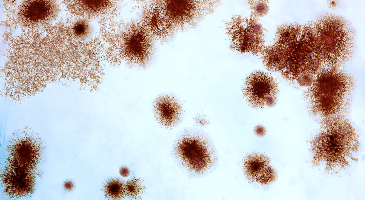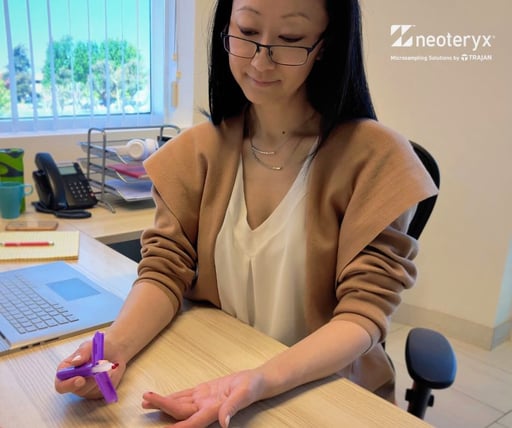Share this
sample storage factors when using dried microsamples
by Neoteryx Microsampling on Sep 27, 2021 9:00:00 AM
 Using dried microsamples collected through fingerstick sampling for research studies can often replace the traditional practice of using venipuncture to collect liquid blood samples in vials. Dried specimen microsampling reduces biohazard risks while also increasing the feasibility of sample storage and shipment. However, the question arises about how long dried specimen samples can be stored.
Using dried microsamples collected through fingerstick sampling for research studies can often replace the traditional practice of using venipuncture to collect liquid blood samples in vials. Dried specimen microsampling reduces biohazard risks while also increasing the feasibility of sample storage and shipment. However, the question arises about how long dried specimen samples can be stored.
Wet Blood Samples vs. Dried Blood Samples
Collection and Storage
For wet blood tests to be accurate, the samples must be collected, stored, and transported in specific ways. These factors affect their long-term viability. Wet blood samples should be tested soon after collection; usually within four hours.
When serum samples are required for testing, they must be separated from whole blood within two hours after sample collection. Depending on the test, additives are sometimes used, which affect sample testing and storage.
Temperature
Blood sample storage requires specific temperatures depending on the type of study for which the samples will be analyzed. The samples may be stored at room temperature (about 20 °C), refrigerated (approximately 4 °C), or frozen (–20 °C or below).
Length of Storage
Six weeks has long been considered the blood sample “shelf life” by blood banks. However, a new study shows that red blood cells become less effective in supplying oxygen-rich cells in the body within 3 weeks of storage. Extended storage of blood in frozen or refrigerated temperatures can hinder its viability.
Advantages of Using Dried Samples
Due to these challenges encountered with wet sample collection, many researchers have switched to dried blood sampling for research and clinical trials. One advantage is that researchers can remotely collect samples from geographically diverse populations when using dried blood spot (DBS) methods. With a dried sampling approach, study participants don’t have to visit a clinic or research site for professional assistance with sample collection. They can use an easy finger-stick method for remote specimen collection at home or work.
 Dried blood spot sampling works well with the finger-stick method, but DBS cards also present some challenges, including lack of sampling accuracy and spot area visibility due to hematocrit effects.
Dried blood spot sampling works well with the finger-stick method, but DBS cards also present some challenges, including lack of sampling accuracy and spot area visibility due to hematocrit effects.
These issues have prompted researchers to explore more advanced methods of dried blood sampling: the volumetric absorptive microsampling technique enabled by Mitra® devices equipped with special VAMS® tips.
These absorb the precise sample volume needed for clinical studies. The samples collected using the Mitra devices don’t require special handling. They are housed inside a protective plastic cartridge immediately after collection. They are slipped into a sealed specimen pouch that includes a sachet of drying desiccant, which allows them to dry while in transit to the lab.
Since study participants can collect their samples at home, dried microsampling allows for remote research studies. Remote or decentralized studies were previously less feasible because of the challenges associated with collecting, handling, and storing wet specimen samples. More researchers are finding that Mitra microsamples are easy to use and store with robust sample stability. They can reference the published literature for guidance on sample storage timelines based on the experiences of other researchers working with various analytes or assays. Most importantly, dried volumetric absorptive microsamples provide the precision needed for accurate scientific analysis.
For more information on how Neoteryx microsampling products from Trajan help researchers, visit our Technical Resource Library.

Share this
- Microsampling (206)
- Research, Remote Research (119)
- Venipuncture Alternative (105)
- Clinical Trials, Clinical Research (83)
- Mitra® Device (73)
- Therapeutic Drug Monitoring, TDM (51)
- Dried Blood Spot, DBS (39)
- Biomonitoring, Health, Wellness (30)
- Infectious Disease, Vaccines, COVID-19 (24)
- Blood Microsampling, Serology (23)
- Omics, Multi-Omics (21)
- Decentralized Clinical Trial (DCT) (20)
- Specimen Collection (18)
- Toxicology, Doping, Drug/Alcohol Monitoring, PEth (17)
- Skin Microsampling, Microbiopsy (14)
- hemaPEN® Device (13)
- Preclinical Research, Animal Studies (12)
- Pharmaceuticals, Drug Development (9)
- Harpera Device (7)
- Industry News, Microsampling News (5)
- Antibodies, MAbs (3)
- Company Press Release, Product Press Release (3)
- Environmental Toxins, Exposures (1)
- July 2025 (1)
- May 2025 (1)
- April 2025 (2)
- December 2024 (2)
- November 2024 (1)
- October 2024 (3)
- September 2024 (1)
- June 2024 (1)
- May 2024 (1)
- April 2024 (4)
- March 2024 (1)
- February 2024 (2)
- January 2024 (4)
- December 2023 (3)
- November 2023 (3)
- October 2023 (3)
- September 2023 (3)
- July 2023 (3)
- June 2023 (2)
- April 2023 (2)
- March 2023 (2)
- February 2023 (2)
- January 2023 (3)
- December 2022 (2)
- November 2022 (3)
- October 2022 (4)
- September 2022 (3)
- August 2022 (5)
- July 2022 (2)
- June 2022 (2)
- May 2022 (4)
- April 2022 (3)
- March 2022 (3)
- February 2022 (4)
- January 2022 (5)
- December 2021 (3)
- November 2021 (5)
- October 2021 (3)
- September 2021 (3)
- August 2021 (4)
- July 2021 (4)
- June 2021 (4)
- May 2021 (4)
- April 2021 (3)
- March 2021 (5)
- February 2021 (4)
- January 2021 (4)
- December 2020 (3)
- November 2020 (5)
- October 2020 (4)
- September 2020 (3)
- August 2020 (3)
- July 2020 (6)
- June 2020 (4)
- May 2020 (4)
- April 2020 (3)
- March 2020 (6)
- February 2020 (3)
- January 2020 (4)
- December 2019 (5)
- November 2019 (4)
- October 2019 (2)
- September 2019 (4)
- August 2019 (4)
- July 2019 (3)
- June 2019 (7)
- May 2019 (6)
- April 2019 (5)
- March 2019 (6)
- February 2019 (5)
- January 2019 (8)
- December 2018 (3)
- November 2018 (4)
- October 2018 (7)
- September 2018 (6)
- August 2018 (5)
- July 2018 (8)
- June 2018 (6)
- May 2018 (5)
- April 2018 (6)
- March 2018 (4)
- February 2018 (6)
- January 2018 (4)
- December 2017 (2)
- November 2017 (3)
- October 2017 (2)
- September 2017 (4)
- August 2017 (2)
- July 2017 (4)
- June 2017 (5)
- May 2017 (6)
- April 2017 (6)
- March 2017 (5)
- February 2017 (4)
- January 2017 (1)
- July 2016 (3)
- May 2016 (1)
- April 2016 (2)


No Comments Yet
Let us know what you think